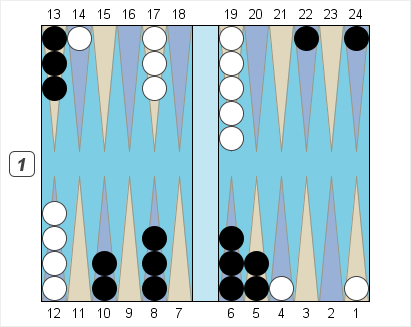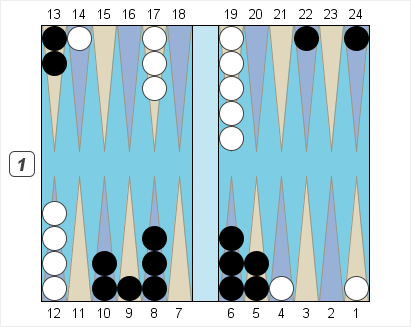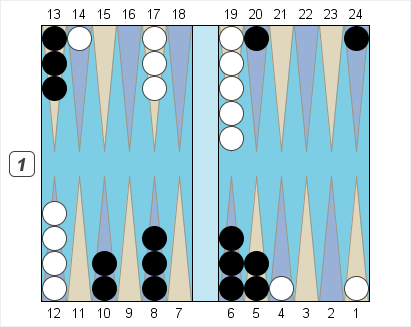The Gammon Press is pleased to announce the publication of Kit Woolsey’s new book, The Backgammon Encyclopedia, Volume 2. This new book builds on Kit’s work in Volume 1 by examining new doubling reference positions in these 10 categories:
1) Early Advantage
2) The Semi-Blitz
3) One Man Back
4) On the Bar
5) Containment
6) Hitting a Blot
7) Escape
8) Priming
9) Crunching
10) Racing
The Backgammon Encyclopedia, Volume 2 is available now. You can order it from the Backgammon Books section on this website. The price is $30 plus shipping.
Here’s a brief excerpt from the beginning of Chapter 2.
2. The Semi-Blitz
A traditional early blitz is usually an all or nothing game plan. The attacker quickly makes a deep inner board point or two, then fights to make more points while preventing his opponent from anchoring. If the defender hits a checker and wins the fight for an anchor, he will usually have at least equalized the position.
A semi-blitz is different. In a semi-blitz the attacker has made two or three strong inner board points, while the defender has split his back checkers but doesn’t yet have an anchor. The attacker has the potential to blitz with a couple of good rolls. If the dice don’t cooperate, the attacker can switch and play a more normal priming and escaping game. His development lead by itself isn’t sufficient for a cube, and neither are the chances of the blitz working. The combination of these, however, gives the attacker a strong position.
Here is a typical semi-blitz in its early stages.
Position 2-1

Black – Pips 157
Black on roll. Cube action?
Extreme Gammon Rollouts:
No double: +0.66
Double, Take +0.67
Double, Pass +1.00
Black has the lead in development, with his made 5-point and 10-point. He has also managed to split his back checkers, while White has no points and an outfield blot. Black also has a small racing lead.
If White had a defensive anchor, Black would be far from a cube. White’s position would be sound, and even if Black made another inner board point White’s position will still be fine. However, White’s blot on Black’s 4-point is vulnerable, and Black has three builders poised to attack. If Black succeeds in making the 4-point on White’s head, Black will have improved his offense and White will be on the bar. A full blitz isn’t likely since Black doesn’t have too much ammunition in the attacking zone, but it’s still a possibility. Just putting White on the bar is a big gain for Black, since even if White enters immediately his development will be delayed for a roll.
Even with these various possibilities, Black’s has just a borderline double and White’s take is trivial. Black’s threats, while real, are not that decisive. On the other hand, if White wins the fight for Black’s 4-point the game will be nearly even.
When a blitz is possible, however, every new builder can make a big difference. Let’s see how much difference a new builder makes here, by moving the spare on the midpoint to Black’s 9-point.
Position 2-2

Black – Pips 153
Black on roll. Cube action?
Extreme Gammon Rollouts:
No double: +0.82
Double, Take +0.95
Double, Pass +1.00
Wow! That apparently small change makes quite a difference. Black’s winning chances jump from 65% to 68%, with a big increase in gammons. Now Black has a very strong double. White still has a take, but not by much. That extra builder just about doubles the number of rolls which make the 4-point on White’s head. In addition, if the checker on the 9-point isn’t used immediately it’s still available for the future to help make valuable points.
When a possible blitz is in the making, another blot exposed to a direct shot can make quite a difference in the evaluation of the position. Extra blots also matter in a semi-blitz, since sending another checker back helps the attacker. How much does that factor matter?
Position 2-3

Black – Pips 155
Black on roll. Cube action?
Extreme Gammon Rollouts:
No double: +0.76
Double, Take +0.80
Double, Pass +1.00
Here we’ve moved Black’s back checker up to the 20-point where it has a direct shot at White’s outfield blot. Interestingly enough, that doesn’t change things too much. Black has a decent double, of course, but White still has a big take. The threat of hitting the outfield checker, while worth something, isn’t too important, since White can use that third checker back to more easily build an anchor. Black’s sixes are also duplicated, which reduces the value of a hit in the outfield by a bit. If Black’s hitting number in the outfield were a number which didn’t hit on Black’s 4-point, his position would be a lot stronger.





